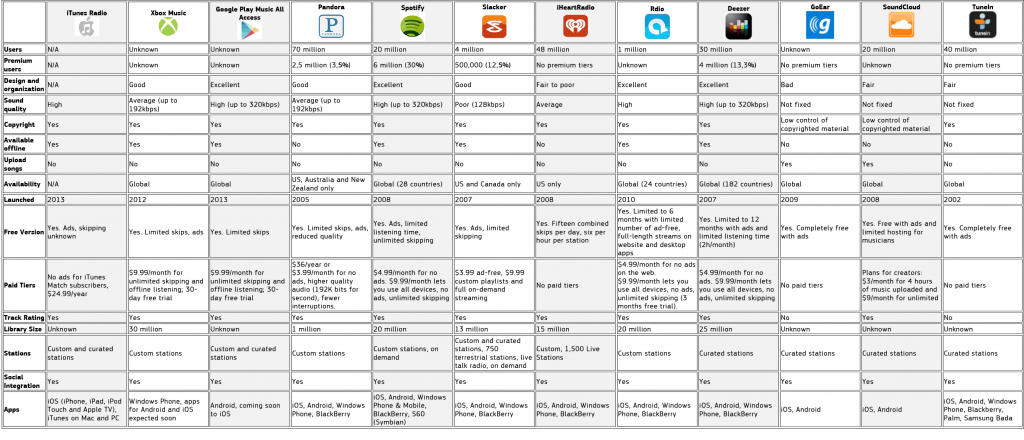2013 5
On How I Gave Up On Music Piracy
Published by MartinVarsavsky.net in Internet & Technology with
It has been quite a while since I stopped downloading music. It’s not that I was afraid of getting caught for illegal downloads– in Spain, internet piracy is not a criminal offense. Instead, I gave up on downloading music, even in a country with few penalties for doing so, because cloud services are just better.
Downloading an mp3, whether legally or illegally, is slow, boring and expensive. Slow because it takes time to find a specific song, download it and then sync the songs with whatever device you want to use. Boring because the process (of downloading and paying) is tedious. And expensive because even though you don’t pay for the download, paying for CDs, hard drives or any other file-storage devices ends up being more expensive than any of the options in the table included above.
Listening to music from the cloud is the most recent trend in the world of online audio. That’s because it is fast, fun and cheap. You don’t have to wait to listen to what you want, be it online or downloaded onto your device via offline mode. It’s fun because cloud music has a social aspect in that you can see what your friends are listening to, get recommendations, read lyrics at the same time you are listening to the music and much more. And cheap because the prices, due to the high level of competition, is far lower than any external hard drive to store mp3s.
Pandora is the service with the most users – currently at 70 million. Behind them are iHeartRadio (48 million), TuneIn (40 million) and Deezer (30 million). It’s also worth noting the strength of premium memberships in Spotify: their 6 million premium subscribers make up roughly 30% of their total number of subscribers, making Spotify stand out among the rest.
All of the services I included in the table have a free version, and their restrictions are often the same: ads, a limited amount of song “skips”, lower audio quality, or limited amount of free listening time.
It’s in the paid versions where you notice important differences. The new iTunes Radio seems to be the best deal: for $25 per year it offers music without limits or ads. Pandora offers the same for $36 a year. For monthly subscriptions, the prices are quite similar. The cheapest is Pandora, which for $4 gives the best quality music without ads. Behind them is Spotify, which for $5 provides music without ads but without a mobile option. Monthly unlimited plans, for all devices and with no ads, do not drop below $10 in any of the platforms.
The size of the iTunes Radio music catalogue is still unknown, making the 30 million tracks available in Xbox Music the most attractive in terms of music variety. Pandora’s library is quite poor in comparison, with only 1 million songs.
Sound quality is surprisingly variable among the services, and many of the platforms don’t make this information public. Among those that do, Google, Spotify and Deezer claim the highest bit rate at up to 320kbps.
Another aspect worthy of noting is that of availability. The majority of the platforms analyzed are accessible to anyone, anywhere. Only Pandora, Slacker and iHeartRadio limit access – they are only available in the US, Canada, New Zealand and Australia.
Lastly, I took a look at the apps that each service provides. With our world becoming increasingly more mobile, most people only listen to music from their mobile device. Therefore my opinion is that any good music service should be available for all operating systems. Among the services I analyzed, Pandora, Spotify, Slacker and iHeartRadio can be found on all operating systems whereas iTunes Radio will only be available for iPhone users, Xbox Music can only be obtained through Windows Phone, and Google Play is only available for Android.
I personally prefer Spotify: it’s got great sound quality, an ample music library and apps that improve the user’s listening experience. For copyright-free music and DJ remixes I tune into SoundCloud.
Follow Martin Varsavsky on Twitter: twitter.com/martinvars




